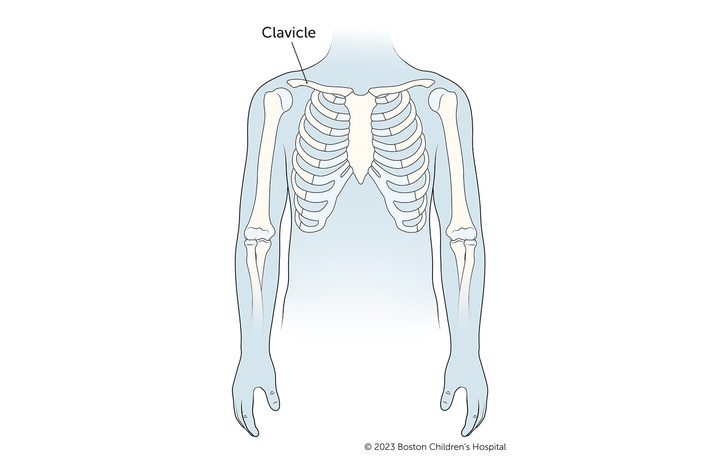Clavicle Fracture | Symptoms & Causes
What are the symptoms of a clavicle fracture?
Symptoms include:
- pain around the shoulder or collarbone
- trouble moving the affected shoulder or arm
- swelling, bruising, or tenderness around the collarbone
- a prominence or tent-like appearance of the skin in the area of the collarbone
What causes clavicle fractures?
Clavicle fractures are common in contact sports like football, hockey, or lacrosse, when the shoulder suffers a direct blow to shoulder of another player, to the boards in hockey, or to the ground. Many clavicle fractures happen when a child or teen falls onto their shoulder, such as falling off a bike or scooter, playground equipment, skis, or skates. The injury can also be caused by a car accident.
Clavicle Fracture | Diagnosis & Treatments
How are clavicle fractures diagnosed?
Your child’s doctor will ask about the injury and how it happened. They will examine your child’s arm and shoulder and order an X-ray to confirm the diagnosis.
How are clavicle fractures treated?
Your child will need to wear a brace or sling to immobilize their collarbone while it heals. The purpose of this is to keep your child comfortable. As their pain improves, your child may be able to stop wearing the sling or brace full time.
Unlike other broken bones, broken clavicle fractures don’t need to be set. Similarly, casts are not used for clavicle fractures since a cast would have to cover your child’s entire chest and shoulder to immobilize the area.
In special cases, your child’s doctor may recommend surgery. However, research conducted at Boston Children’s has shown that for the vast majority of fractures, even ones where the fractured bone fragments do not line up perfectly, adolescents treated without surgery undergo reliable and uneventful healing and report the same shoulder function, quality of life, and satisfaction as those who undergo surgery for clavicle fracture.
Some people have a visible bump after their clavicle heals. The bump generally becomes smaller over time as the bone continues to repair itself, even for older adolescents.

Rethinking surgery for adolescent clavicle fractures
A landmark study comparing surgical to non-surgical treatment of clavicle fractures in patients between the ages of 10 and 18 showed that in this age group, surgery did not lead to superior outcomes. Rather, it increased patients' risk of complications.
How active can my child be while recovering from a clavicle fracture?
Often, doctors will recommend using the shoulder sling most of the time for the first two weeks after the injury, then when at school and out of the house for the next month or so. It is OK for your child to move their arm when it feels comfortable to do so. However, they should not lift anything heavy or bear weight with the injured arm until their doctor tells them it is safe.
A second fall or injury could slow the healing process or cause a refracture (the collarbone breaks again) or even require surgery. Therefore, until your doctor clears them to return to specific activities, your child should avoid any activities that put them at risk such as:
- playing on playground structures like jungle gyms or swing sets
- sports like basketball, hockey, soccer, or gymnastics
- biking, ice skating, skiing or snowboarding
When can my child return to sports after a clavicle fracture?
Returning to sports training and many lower risk sports is often allowed by around six weeks after the injury. However, children and teens typically need to avoid contact sports and other higher risk activities for three months after a clavicle fracture. Your child’s doctor can tell you when the bone is strong enough for your child to return to their previous activities.
How we care for clavicle fractures at Boston Children's Hospital
The Orthopedics and Sports Medicine Department and Sports Medicine Division at Boston Children’s Hospital are dedicated to providing the best for children, adolescents, and young adults. Our team is made up of experts in child and adolescent growth patterns and treatments that promote optimal recovery from injury. We understand the essential role sports play in many of our patients’ lives and work with our patients a treatment plan to help them achieve their personal and athletic goals.
Whenever possible, we take a non-surgical approach to care.When an injury requires surgery, we look for the least invasive options and practice pain management techniques that promote faster recovery with minimal exposure to anesthesia.
Part of the Sports Medicine Division, The Micheli Center for Sports Injury Prevention is dedicated to the prevention of sports injuries. Through research and clinical training, we offer practical strategies that help young athletes reduce their risk of injury while enhancing their sports performance. Our rehabilitation and strength training programs help injured athletes return to play stronger and healthier.
Boston Children’s Hospital is the lead site for the largest prospective study ever conducted on adolescent clavicle fractures, which represents collaborative work by 8 different pediatric hospitals around the U.S. The study is designed to better understand how adolescent heal, grow, and respond to treatment of this common injury, whether treated with surgery or non-operative methods. A number of award-winning studies have come out of these research studies and changed the way the orthopedic community views adolescent clavicle fractures and their treatment. Your doctor at Boston Children's Hospital is happy to share more of the details of this research and how it might relate to your child and the injury.



